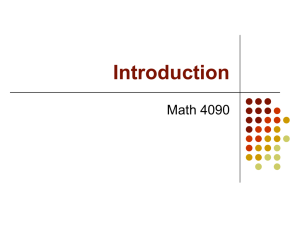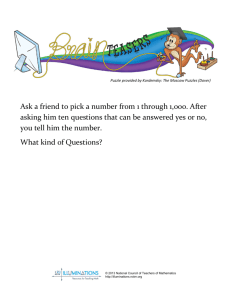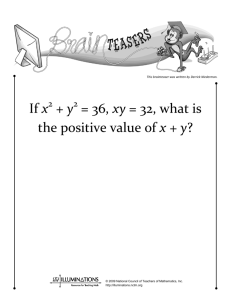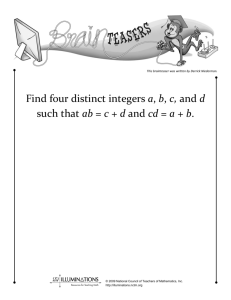Slide 1 - Symphony Math
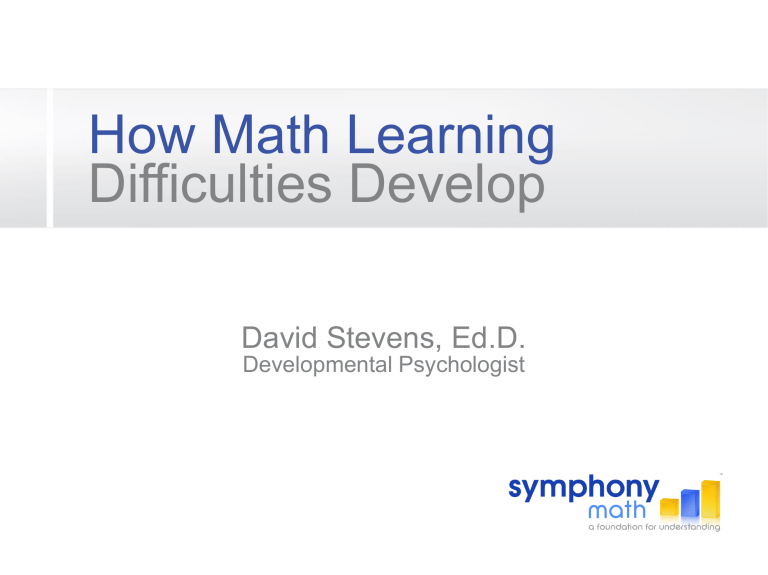
How Math Learning
Difficulties Develop
David Stevens, Ed.D.
Developmental Psychologist
01
Developmental Readiness
Some students arrive in kindergarten and first grade without having the necessary foundation for math instruction.
Robbie Case & Sharon Griffin
Number Knowledge Test
Have a candy. Here are 2 more.
How many do you have?
Which pile has more?
(Show two piles of chips)
How many triangles are there?
(Show mixed array)
If you had 4 candies and received 3 more, how many would you have?
What comes two numbers after
7?
Which number is bigger/smaller?
(Show two arabic digits)
0
Not at Risk At Risk
18
24
25
38
50
64
72
79
85
75
100
92
93
100
96
100
Robbie Case & Sharon Griffin
02
Mile Wide Inch Thick
The large number of required topics does not allow some students the time they need to understand foundational concepts.
Schmidt, McKnight, & Raizen 1997
Number of Topics per Grade
Top Achieving Countries NCTM
39
37
34
35
25 25
24 24
20
15
8
3
1st
3
2nd 3rd 4th
Grade
5th
17
16
18
6th 7th 8th
Center for Research in Math & Science Education, Michigan State University
Grade 4 International
Test Question
80%
“There are 600 balls in a box, and 1/3 of the balls are red.
How many red balls are in the box?”
38%
Percent Correct
Center for Research in Math & Science Education, Michigan State University
03
Teacher Training Programs
Teacher training programs traditionally emphasize
Language Arts instruction.
www.nctq.org
100%
75%
50%
25%
13%
%
Colleges Providing Sufficient Training
04
Memorization over Understanding
Some students move forward in the early grades only by using counting and memorization strategies.
How Many cookies?
Which is larger 8 or 9?
5 + 3 = ?
4 x 6 = ?
328
+ 486
2 + 3 = ?
3 + 2 = ?
2 + ? = 5
5 = 3 + ?
5 - 3 = ?
5 - 2 =?
05
Curriculum Becomes More Complex
As the curriculum becomes more complex the counting and memorization strategies are not effective.
The parts are of equal size
The whole is divided
The parts equal the whole
There are a specific number of parts
The complexity of fractions make it more likely that students will forget that fractions represent quantities.
This leads to memorization without understanding:
“Find the common denominator, then add”
“Flip it and multiply”
“The bigger the denominator the smaller the fraction”
06
Outcomes
Many Students are not developing the foundation they need for long-term success in mathematics.
100%
75%
50%
25%
34%
National Center for Educational Statistics -- 2009
%
Grade 8 Passing Rate
07
Solutions
Recent research documents recognize these problems and agree on proven solutions.
Changing Course
“Teachers face long lists of learning expectations to address at each grade level, with many topics repeating from year to year. Lacking clear, consistent priorities and focus, teachers stretch to find the time to present important mathematical topics effectively and in depth.” www.nctm.org/focalpoints
NCTM Now Recommends
Instruction should devote “the vast majority of attention” to the most significant mathematical concepts.
Focus on developing problem solving, reasoning, and critical thinking skills.
Develop deep understanding, mathematical fluency, and an ability to generalize.
www.nctm.org/focalpoints
National Math Panel Report
“The manner in which math is taught in the
U.S. is "broken and must be fixed." www2.ed.gov/about/bdscomm/list/mathpanel/reports.html
National Math Panel Recommendations
Math curricula should:
Be "streamlined and should emphasize a well-defined set of the most critical topics in the early grades."
Emphasize "the mutually reinforcing benefits of conceptual understanding, procedural fluency, and automatic recall of facts."
Teach with "adequate depth."
Have an "effective, logical progression from earlier, less sophisticated topics into later, more sophisticated ones."
Have teachers regularly use formative assessment.
www2.ed.gov/about/bdscomm/list/mathpanel/reports.html
1.
Screen all students and provide interventions to students identified as at-risk.
2. Instructional materials for students should focus intensely on in-depth treatment of whole numbers.
3. Instruction during the intervention should be explicit and systematic.
4. Include instruction on solving word problems that is based on common underlying structures.
5. Students should work with visual representations.
6. Devote ten minutes in each session to fluent retrieval of basic arithmetic facts.
7.
Monitor student progress.
8. Include motivational strategies.
ies.ed.gov
For over a decade, research studies of mathematics education in high performing countries have pointed to the conclusion that the mathematics curriculum in the
United States must become substantially more focused and coherent in order to improve mathematics achievement in this country.
To deliver on the promise of common standards, the standards must address the problem of a curriculum that is “a mile wide and an inch deep.”
These Standards are a substantial answer to that challenge.
www.corestandards.org
Kindergarten Standards www.corestandards.org
The Best Practices
3.
4.
5.
1.
2.
6.
7.
8.
9.
10.
Streamline the curriculum to emphasize the big ideas of mathematics.
Individualize learning experiences to each student’s developmental level.
Adapt to the learning style of each student.
Bridge from the concrete to the abstract.
Provide concrete feedback and levels of scaffolding to provoke thinking.
Develop
Promote
Draw knowledge of concepts AND math facts.
cognitive flexibility and problem solving.
on intrinsically motivating aspects of mathematics to inspire learning
Teach for mastery.
Introduce concepts at the simple level and build to the complex level.
.
11.
12.
Help students make connections between concepts.
Guide instruction with formative assessment.

